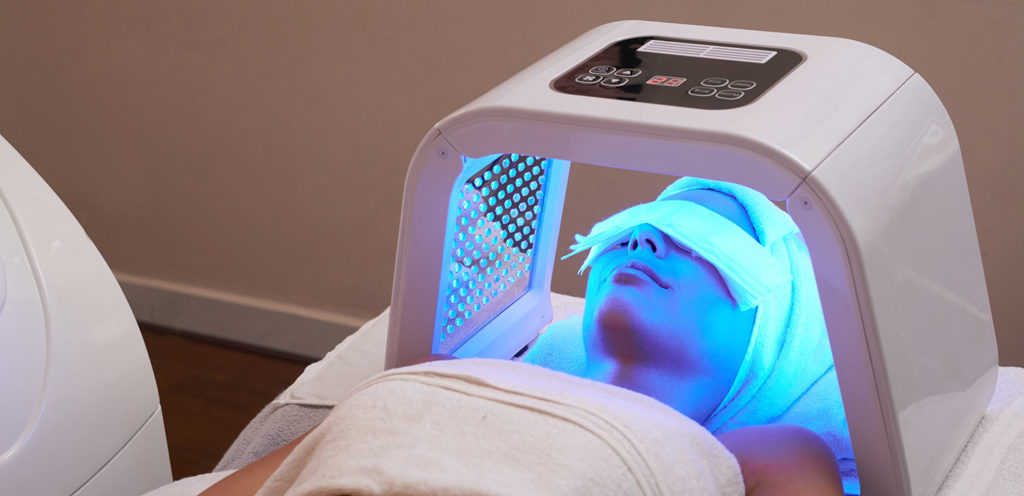About Red Light Therapy
LED, or light emitting diode therapy, is a skincare treatment that uses varying wavelengths of light, including red, white, yellow and blue.
NASA originally developed it for plant growth experiments on shuttle missions and later found it to have promise for wound treatment. LED light therapy is now used by our aestheticians to help reverse the signs of aging!
What is LED light therapy?
Light emitting diode (LED) light therapy is growing in popularity and after a strong demand from our patients- we heard you! We can now use this technology in our office as a stand-alone treatment or as an add-on treatment just for you!
Using varying LED wavelengths, this skincare technique helps:
- Accelerate healing
- Boost collagen
- Increase elastin production
- Reduce fine lines, wrinkles and sun damage
- Treat acne
- Reduce inflammation
- Promote anti-aging effects (tightens, tones and smooths)
- Treat surgical and accidental wounds as well as muscle and joint pain and inflammation
You may be a candidate for LED light therapy if you have these types of skincare concerns and haven’t gotten the results you want from over-the-counter (OTC) skin products. LED therapy is also safe for all skin colors, and it doesn’t cause any burning.
Safety
Unlike other types of light therapy, LEDs do not contain ultraviolet rays. Therefore, they’re safe for regular use.
LED light therapy doesn’t cause burns compared to other anti-aging treatments such as chemical peels, dermabrasion, and laser therapy. It may be safe for all skin colors and types.
You shouldn’t use LED light therapy if you take Accutane for acne or if you’re experiencing skin rashes.
Side effects are rare, but may include increased inflammation, redness, and rashes.
Convenience
Office procedures take 20 minutes at a time. You’ll need to go back once a week for up to 10 weeks, then only once every few months.
At-home LED devices can be used at your convenience without having to go to any appointments. The downside is that the results may not be as dramatic.
Efficacy
When used as directed, LED light therapy can improve your skin over time. You’ll need maintenance treatments to maintain your results.
How it works
LED light therapy has an established history of skin uses. The U.S. Navy SEALs began using it in the 1990s to help heal wounds quickly and to help regenerate damaged muscle tissues.
There are different frequencies, or wavelengths, used with LED light treatment. These include red, white, yellow and blue light frequencies, which don’t contain ultraviolet rays and are readily absorbed into the skin.
Red light
Red, or infrared, light is used for treating the epidermis, which is the outer layer of skin. When the light is applied to your skin, the epidermis absorbs it and then stimulates collagen proteins.
In theory, more collagen means that your skin will look smoother and fuller, which can reduce the appearance of fine lines and wrinkles. Red LED light is also thought to reduce inflammation while improving circulation, which can give you a healthier glow.
Blue light
Blue LED light therapy, on the other hand, targets the sebaceous glands, which are also called oil glands. They’re located beneath your hair follicles.
Sebaceous glands are necessary for lubricating your skin and hair so that it doesn’t dry out. However, these glands can become overactive, leading to oily skin and acne.
The theory is that blue LED light therapy can target these oil glands and make them less active. In turn, you may see fewer acne breakouts. Blue light can also kill acne-causing bacteria beneath the skin, which can help treat severe acne pimples, including cysts and nodules.
Oftentimes, blue LED light is used in conjunction with red LED light to:
- Help treat acne
- Decrease scarring
- Promote anti-inflammatory effects
Procedure for LED light therapy
According to EstheticianEDU, each LED light therapy treatment lasts about 20 minutes. You’ll likely need up to 10 treatments total, depending on the results you’re looking to achieve.
Some providers have you lie down directly under the lights, while others use LED light-infused wands directly over your skin. The choice often depends on the office, as well as the treatment area.
Targeted areas
While LED light therapy can technically be used on any part of the body, its most popular use is for the face. Skin damage tends to occur to your face because it’s exposed to the elements more than other body parts.
LED therapy can also be used on the neck and chest, which are other areas that tend to show signs of aging, in addition to areas prone and suffering from inflammation.
Risks and side effects
Overall, the American Academy of Dermatology deems this procedure safe. Since LEDs don’t contain UV rays, this is considered a safer form of light therapy that won’t cause long-term damage to your skin. The procedure is also noninvasive and has few risks.
Your provider may recommend LED light therapy if you have darker or sensitive skin. Unlike more invasive procedures such as laser therapy, LEDs don’t burn your skin. They also don’t cause any pain.
However, there may still be risks associated with LED light therapy.
If you currently use Accutane for acne, be advised that this powerful drug derived from vitamin A increases your skin’s sensitivity to light and may cause scarring in some instances.
Do not use LED light therapy if you’re using anything on your skin that makes you sensitive to sunlight.


